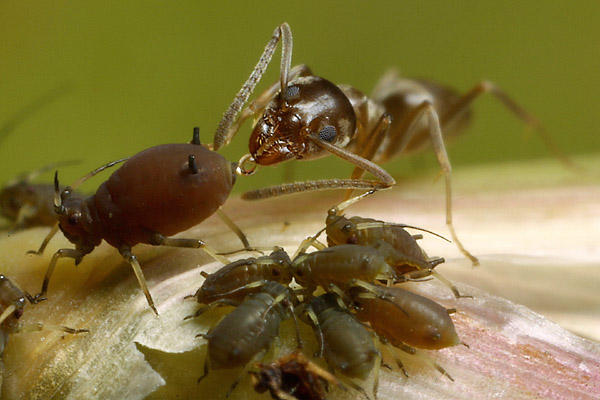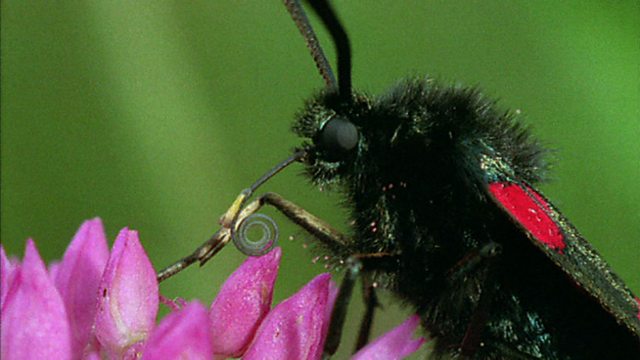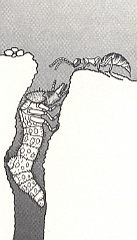Intimate relationships in the natural world
 is
is
This is a small excerpt from an essay that I wrote about life in insect world.Just because the biology tag has been activated I decided that it would be a good occasion to share this.This note assumes no prior knowledge of the reader and is mainly based on non-rigorous stuff(can almost be called popular science).I hope you guys will find it interesting.The essay was inspired by the BBC documentary "Life in the Undergrowth" by Sir David Attenborough.
A small insect species called the aphids are extremely vulnerable to their insect predators such as the ladybug.So to protect themselves,the aphids secrete honey dew which is eaten and collected by ants.These ants in turn provide protection to the aphids from their predators.
 ing
ing
As soon as the bernette moth inserts it's long probosis into a pyramidal orchid flower a horse shoe shaped mass of pollen gets attached to it.When the moth goes to other flowers,a speck of pollen is transported and inserted into the flower and hence helping in pollination.Sadly the moth is incapable of getting rid of the pollen mass
 imf
imf
The tiger beetle larva is a successful ant hunter.The larva plugs the entrance to it's den by it's head.Any ant touching it's head is eaten up immediately. Methocha is a wingless parasitic wasp which mimics an ant.One of it's main weapons is it'as agility.When the tiger beetle goes for the kill it slips between it's jaws,grabs the larva's soft body and stings it.The sting paralyzes the larva and the methocha lays it's eggs on it's body.Then it pulls the larva down and blocks the entrance to it's burrow to ensure safety of the offsprings.After the eggs hatch the offsprings feed on the beetle larva's preserved flesh!!
 jd
jd
Flowers generally decorate themselves with bright colors to attract insects to help them in pollination.Just because some insects travel from flower to flower in search of nectar and in turn fertilize them they are popularly called "magic bullets".but insect predators can take advantage of this too.In the picture white crab spider waits in ambush taking advantage of a flower's advertising.
 dw
dw
Easy Math Editor
This discussion board is a place to discuss our Daily Challenges and the math and science related to those challenges. Explanations are more than just a solution — they should explain the steps and thinking strategies that you used to obtain the solution. Comments should further the discussion of math and science.
When posting on Brilliant:
*italics*or_italics_**bold**or__bold__paragraph 1
paragraph 2
[example link](https://brilliant.org)> This is a quote# I indented these lines # 4 spaces, and now they show # up as a code block. print "hello world"\(...\)or\[...\]to ensure proper formatting.2 \times 32^{34}a_{i-1}\frac{2}{3}\sqrt{2}\sum_{i=1}^3\sin \theta\boxed{123}Comments
Great examples of ecological relationships like commensalism, mutualism, predation and so on! Well explained.
Log in to reply
You should check out some of my biology problems. I have one about symbiotic relationships like the one above.
simply brilliant!!! :)
Nice!!! :)
Well Eddie(don't mind me calling you by this name) your essay is simply awesome and my Question is..
Did you watch COSMOS on National Geographic Channel and more ,precisely in that did you watch the episode in which they decribed LIFE IN A DEWDROP? If not make a go for it. It's worth watching!
AND tell me how it was..for others joining in can also tell me..
Yours Friendly :)
Log in to reply
Hi! Do you know where I can watch some previous episode (actually from the beginning) somewhere? Because I missed it everytime I wanted to watch. :/
Log in to reply
Well apparently I don't know if there is any possible source of those episodes being available :/
But DON"T miss them now. Well I'll surely let you know if I come to know give me your e-mail ID
Log in to reply
Sure. arbaskara0[at]gmail[dot]com. Thank you very much!
Watching COSMOS is at the top of my wishlist but sadly I have not been able to watch it as I have been a bit too busy for the last few weeks .I'll watch it as soon as I get a bit of spare time ...... Thanks for the recommendation :)
Thanks for sharing! I'm always interested on the insect world :)
You should have mentioned the symbiotic relationship between acacia trees and ants.